Related Research Articles

Bangladesh is a densely populated, low-lying, mainly riverine country located in South Asia with a coastline of 580 km (360 mi) on the northern littoral of the Bay of Bengal. The delta plain of the Ganges (Padma), Brahmaputra (Jamuna), and Meghna Rivers and their tributaries occupy 79 percent of the country. Four uplifted blocks occupy 9 percent and steep hill ranges up to approximately 1,000 metres (3,300 ft) high occupy 12 percent in the southeast and in the northeast. Straddling the Tropic of Cancer, Bangladesh has a tropical monsoon climate characterised by heavy seasonal rainfall, high temperatures, and high humidity. Natural disasters such as floods and cyclones accompanied by storm surges periodically affect the country. Most of the country is intensively farmed, with rice the main crop, grown in three seasons. Rapid urbanisation is taking place with associated industrial and commercial development. Exports of garments and shrimp plus remittances from Bangladeshis working abroad provide the country's three main sources of foreign exchange income.
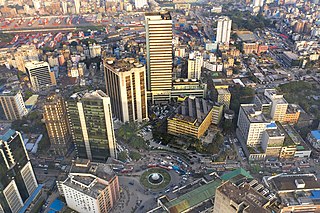
The economy of Bangladesh is a major developing market economy. As the second-largest economy in South Asia, Bangladesh's economy is the 33rd largest in the world in nominal terms, and 25th largest by purchasing power parity. Bangladesh is seen by various financial institutions as one of the Next Eleven. It has been transitioning from being a frontier market into an emerging market. Bangladesh is a member of the South Asian Free Trade Area and the World Trade Organization. In fiscal year 2021–2022, Bangladesh registered a GDP growth rate of 7.2% after the global pandemic. Bangladesh is one of the fastest growing economies in the world.

Chittagong, officially Chattogram, also known as Chatgaon, is the second-largest city in Bangladesh. Home to the Port of Chittagong, it is the busiest port in Bangladesh and the Bay of Bengal. It is the administrative seat of an eponymous division and district. The city is located on the banks of the Karnaphuli River between the Chittagong Hill Tracts and the Bay of Bengal. The Greater Chittagong Area had a population of more than 5.2 million in 2022. In 2020, the city area had a population of more than 3.9 million. The city is home to many large local businesses and plays an important role in the Bangladeshi economy.
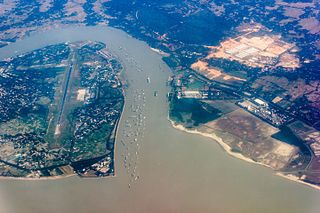
The Karnaphuli River, is the largest and most important river in Chittagong and the Chittagong Hill Tracts. It is a 667-metre (2,188 ft) wide river in the south-eastern part of Bangladesh. Originating from the Saithah village of Mamit district in Mizoram, India, it flows 270 kilometres (170 mi) southwest through Chattogram Hill Tracts and Chattogram into the Bay of Bengal. Before the Padma, it was the fastest flowing river in Bangladesh. It is said to "represent the drainage system of the whole south-western part of Mizoram." Principal tributaries include the Kawrpui River or Thega River, Tuichawng River and Phairuang River. A large hydroelectric power plant was built on the Karnaphuli in the Kaptai region in the 1960s. The mouth of the river hosts the Port of Chattogram, the largest and busiest seaport of Bangladesh.
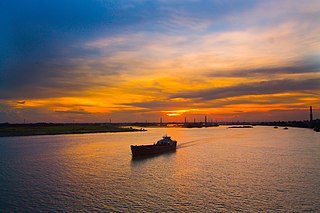
The Buriganga is a river in Bangladesh which flows past the southwest outskirts of the capital city, Dhaka. Its average depth is 7.6 metres (25 ft) and its maximum depth is 18 metres (58 ft). It ranks among the most polluted rivers in the country.

Chittagong District, renamed the Chattogram District, is a district located in south-eastern Bangladesh. It is a part of the Chittagong Division. The port city of Chittagong, which is the second largest city in Bangladesh, is located within this district.
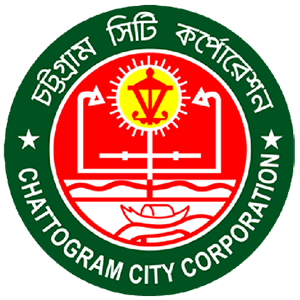
Chattogram City Corporation (CCC) is a self-governing body that governs the municipal areas of Chattogram and some adjoining areas of south-eastern Bangladesh. The CCC government is elected by popular vote every five years.
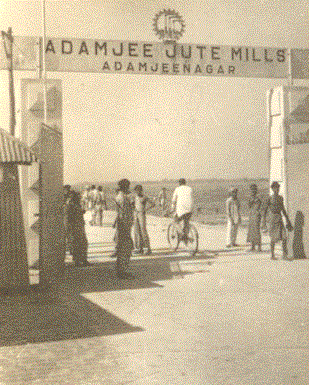
Adamjee Jute Mill was a jute mill in Bangladesh. It was established in Narayanganj in 1950 by the Adamjee Group. It was the second jute mill in East Pakistan after Bawa Jute Mill which was first Jute Mill in East Pakistan. Gradually, the mill became the largest jute mill in the world, exceeding the jute mills of Calcutta, India, and Dundee, Scotland. The mills were nationalised after the independence of Bangladesh in 1972. It was operated by the Bangladesh Jute Mills Corporation before being closed down in 2002.

The Bangladesh Export Processing Zones Authority (BEPZA) is an agency of the Government of Bangladesh and is administered under the jurisdiction of the Prime Minister's Office. Its objective is to manage the various export processing zones in Bangladesh. BEPZA currently oversees the operations of eight export processing zones (EPZ). A ninth zone is scheduled to open in the future. Recently government has announced that in 15 years 100 new EPZ and SEZ will be established. Major General Abul Kalam Mohammad Ziaur Rahman, ndc, psc is the current Executive Chairman of BEPZA. The Government provides numerous incentives for investors for opening factories in EPZs. For example, new factories enjoy tax holidays for 5 years. Also, labour unions and other activities that are often viewed detrimental to productivity, are banned inside the EPZs. In order to stimulate rapid economic growth of the country, particularly through industrialization, the government has adopted an 'Open Door Policy' to attract foreign investment to Bangladesh. The BEPZA is the official organ of the government to promote, attract and facilitate foreign investment in the EPZs. Besides, BEPZA as the competent Authority performs inspection & supervision of the compliances of the enterprises related to social & environmental issues, safety & security at work place in order to maintain harmonious labour-management & industrial relations in EPZs. The primary objective of an EPZ is to provide special areas where potential investors would find a congenial investment climate free from cumbersome procedures. Bangladesh's export revenue in FY23 is $55.55 billion, the highest amount ever.
Chandgaon is a thana of Chattogram District in Chattogram Division, Bangladesh. It comprises the Chandgoan Residential Area and the Kalurghat Industrial Area.
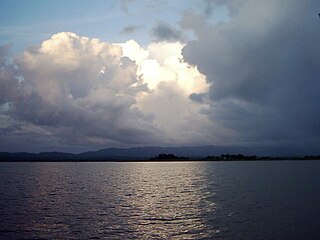
Kaptai is an Upazila of Rangamati District in the Division of Chittagong, Bangladesh. The name of the Kaptai was derived from the Tripuri word "Kaptetoima". It is said that in the past days, the riverine was so wild and full of tropical flora and fauna. A huge amount of several verities of canes used to be found throughout the course of the river that flows from the south, upper ridge, and the river makes its estuary into the Kainsa Khyong.

Halda River is a river in south-eastern Bangladesh. It originates at the Badnatali Hill Ranges in Ramgarh Upazila in the Chittagong Hill Tracts, flows through Fatikchhari Upazila, Bhujpur Thana, Hathazari Upazila, Raozan Upazila and Chandgaon Thana of the Chittagong Metropolitan City, and falls into the Karnaphuli River. The 81-kilometre-long (50 mi) river has a very turbulent tributary, the Dhurung River, which joins Purba Dhalai about 48 kilometres (30 mi) downstream. The river is navigable by big boats 29 km (18 mi) from its mouth up to Nazir Hat, and by small boats 16–24 kilometres (9.9–14.9 mi) further up to Narayanhat. The Halda averages 21 feet (6.4 m) in depth and is 30 feet (9.1 m) at its deepest point.
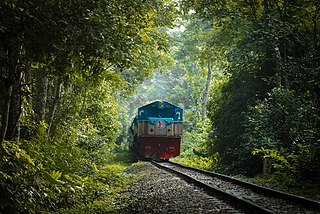
Chittagong Port Authority (CPA) is a government agency of Bangladesh responsible for the management, maintenance and governance of the country's major port of Chittagong, located in the city of Chittagong on the Karnaphuli River nine nautical miles from the shore of the Bay of Bengal of the Indian Ocean. The CPA is part of the Ministry of Shipping.

Chittagong Export Processing Zone (CEPZ), also known as Chittagong EPZ, is the first and one of the eight export processing zones in Bangladesh located at South Halishahar in Chittagong. It was established in 1983. In 2010, CEPZ was ranked third in the best cost-competitiveness category and fourth as the best economic potential in the global ranking in a survey among the world's 700 economic zones carried out by FDi magazine. Up to 2022-23, the EPZ has received cumulative investment of US$2.04 billion and have generated cumulative exports of US$40.5bn.
Bakalia is a thana of Chattogram District in Chattogram Division, Bangladesh. Bakalia thana with an area of 12.33 km2 is located in between 22°26' and 22°19' north latitudes and in between 91°50' and 91°54' east longitudes. It is bounded by Chandgaon Thana on the north, Karnaphuli Upazila and Karnaphuli river on the east and on the south, and Chattogram Kotwali Thana on the west.

Uttara Export Processing Zone (UEPZ), also known as Uttara EPZ or Nilphamari EPZ, is the seventh of the eight export processing zone in Bangladesh located at Nilphamari. It's the only export processing zone of Rangpur division/ north Bengal. It was established in September 2001on about 213,66 acres of lands in Sangloshi area in Nilphamari town.
The Bangladesh Economic Zones Authority or BEZA is an agency of the government of Bangladesh tasked with developing 100 new economic zones. It was create in 2010. Shaikh Yusuf Harun was appointed executive chairman of the authority in July 2021.

Chittagong-13 is a constituency represented in the Jatiya Sangsad of Bangladesh since 2014 by Saifuzzaman Chowdhury of the Awami League.

Parki Beach is a sandy beach in Bangladesh. This beach is between a river and delta in Anwara of Chittagong. It is 20-kilometre (12 mi) from the city of Chittagong. This beach is situated near the Karnaphuli River.
Abul Kalam Mohammad Ziaur Rahman is a major general of the Bangladesh Army and the executive chairman of the Bangladesh Export Processing Zones Authority (Bepza). Prior to join, BEPZA, he was GOC of the 7th Infantry Division and Commander of Barishal Area. He is a former Defence Advisor of the Bangladesh High Commission to India.
References
- ↑ "Karnaphuli Export Processing Zone". BEPZA. Archived from the original on 27 December 2012. Retrieved 10 January 2013.
- ↑ Uddin, Minhaj (3 December 2012). "Karnaphuli EPZ set for full-swing run". The Daily Star (Bangladesh) . Retrieved 10 January 2013.